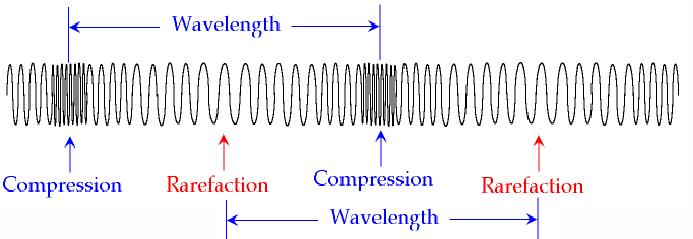Sound Waves
To first truly understand the physics behind
the guitar, we first need to establish a good
basis on how waves work and how they relate to
sound.
Traveling waves come in two fundamental ways,
transverse waves (like those seen on the string of
a guitar) and longitudinal waves (these are the
waves that produce sound). As just mentioned,
sound is produced from longitudinal waves that
create zones of varying pressures by compressing
the air in front of them.

https://www.boundless.com/physics/textbooks/boundless-physics-textbook/waves-and-vibrations-15/waves-125/longitudinal-waves-439-5596/
The picture above does a great job of depicting
what a longitudinal wave looks like in free space
by using a spring to represent the motion of the
air particles. "In a longitudinal wave, the
particles in the medium move parallel to
the direction in which the wave travels" (Knight
561). In the picture above, this is represented by
compression zones followed by zones of very low
pressure (rarefaction zones) throughout the medium
in which the wave travels. In the case of sound
waves, the medium in which the wave propagates
through is air. These compressions and
rarefactions travel through the air and when they
hit your ear drum, you hear the note played based
on how many cycles per second there are, or the
frequency of the wave.

http://seekingintellect.com/2015/02/23/the-history-and-innovation-of-sound.html
Lets take a look at some of the math involved:
As a wave travels along, it moves with a certain
velocity, v. As we know from basic kinematics,
velocity=(distance)/(time). In the case with
periodic waves, the distance is represented by the
wavelength, denoted by the Greek letter lambda
(λ). Another fundamental relationship that needs
to be stated is that frequency=1/T, where T is the
period of time it takes for the wave to travel one
wavelength. By using this, we can see that v=λf.
Another very important observation we need to make
is by relating the above equation with vstring=sqrt(Ts/µ),
where µ is the linear density of the string
(µ=(mass)/(length)). By equating the two equations
we have derived, we can solve for the frequency:
f = (sqrt((TsL)/m)) /
(λ)
Guitar strings utilize these fundamental
properties of waves to produce the correct pitch
(frequency) of the desired note that is to be
played. By looking at this equation, we can see
that strings that are more massive result in much
lower frequencies than less massive strings. This
can easily be seen from the fact that the thicker
more massive strings on a guitar produce the lower
notes (notes with a low frequency). Also, strings
that are under more tension will have higher
frequencies than similar strings with less
tension. On a guitar, as you tighten the tuning
pegs, you are either putting that specific string
under more or less tension and therefore changing
the frequency produced by the string. This is how
tuning pegs work on a guitar.

http://www.wwk.in/physics/waves-and-optics
|